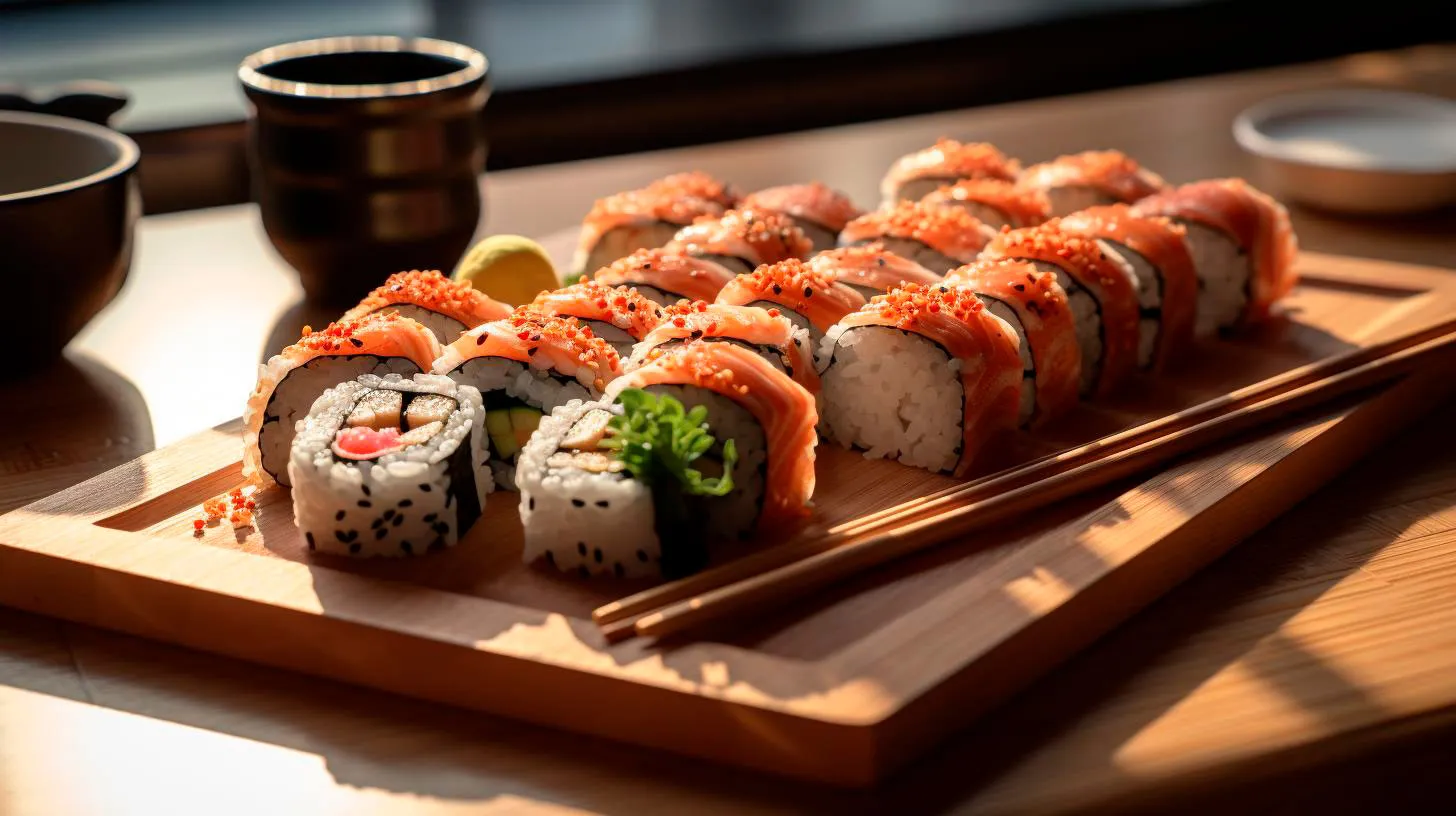Unveiling the Evolution of Nigiri Sushi Edo to Present
The Birth of Nigiri Sushi in Edo
Nigiri sushi traces its roots back to the Edo period in Japan, around the 19th century. During this time, the popular culinary art form of sushi was still in its infancy. Traditional sushi was largely known as “Edomae sushi,” named after the Edo region (present-day Tokyo). It was in this bustling city where the foundations of nigiri sushi were laid.
Edomae sushi was characterized by using freshly caught fish sourced from the nearby Tokyo Bay. Fishermen in Edo realized the importance of preserving the flavor and quality of their catch, leading to the invention of sushi vinegar. This vinegar-infused rice helped to enhance the taste of the raw fish and extended its lifespan. The combination of vinegared rice and fresh fish paved the way for the birth of nigiri sushi.
The technique of molding rice into small bite-sized portions and topping it with a slice of fish was a turning point in sushi history. This innovation allowed sushi to be consumed with ease and introduced a more balanced flavor profile. The minimalism of nigiri sushi allowed the flavors of the fish to shine, emphasizing the natural taste and texture of each variety.
Key Takeaway:
- Nigiri sushi originated in the Edo period in Japan, known as Edomae sushi.
- Sushi vinegar was invented to preserve the flavor and quality of freshly caught fish.
- Nigiri sushi introduced a minimalistic approach, allowing the fish’s natural flavors to be the star.
The Evolution of Nigiri Sushi
As nigiri sushi gained popularity, it continued to evolve and adapt to different tastes and preferences. From the traditional Edomae style, sushi chefs began experimenting with various ingredients, presentation techniques, and flavor combinations. This led to the creation of regional styles and new variations of nigiri sushi.
One such variation is Gunkan-maki, which translates to “warship roll” due to its distinct shape resembling a warship. This style of nigiri sushi features a nori (seaweed) wrap around the rice, allowing for the inclusion of diverse toppings such as sea urchin, quail eggs, or other delicate ingredients that are difficult to place directly on the rice.
Another noteworthy adaptation is the emergence of fusion nigiri sushi. Influenced by international cuisine, sushi chefs began incorporating non-traditional ingredients, creating unique flavor combinations. This fusion-style sushi expanded the possibilities of nigiri sushi, appealing to a wider range of palates and preferences.
In recent years, the rise of technology has also made its mark on the evolution of nigiri sushi. Some sushi restaurants now employ sushi-making robots, ensuring consistent quality and efficiency. While traditionalists may argue for the irreplaceable human touch, these technological advancements demonstrate the continuous innovation within the sushi industry.
Key Takeaway:
- Gunkan-maki introduced a distinctive shape and the ability to incorporate diverse toppings.
- Fusion nigiri sushi combines non-traditional ingredients, expanding flavor possibilities.
- Technology has made its mark with sushi-making robots, showcasing innovation in the industry.
Nigiri Sushi in the Present Day
Today, nigiri sushi continues to delight food enthusiasts worldwide. Sushi restaurants, both traditional and modern, offer an array of choices featuring various fish, seafood, and even vegetarian options. The art of nigiri sushi has become a global phenomenon, spreading its influence far beyond Japan’s borders.
With the increasing demand for sustainable dining, sushi restaurants are now committed to responsibly sourcing their ingredients. Sustainable fishing practices are encouraged, ensuring the long-term availability of the fish species commonly used in nigiri sushi. This shift towards eco-consciousness reflects the evolving values of sushi enthusiasts.
Moreover, dining experiences have become more interactive and engaging. Some sushi establishments now offer omakase, a chef-led experience where diners trust the chef’s expertise to curate a unique nigiri sushi tasting menu. This personalized approach not only showcases the skill of the sushi chef but also provides guests with an unforgettable culinary journey.
Key Takeaways:
- Nigiri sushi has become a global phenomenon, appreciated worldwide.
- Sustainable fishing practices and eco-consciousness are increasingly important in the sushi industry.
- Omakase experiences provide guests with personalized nigiri sushi menus, highlighting the skill of the sushi chef.
In conclusion, the evolution of nigiri sushi from its humble beginnings in Edo to its present-day variations showcases the rich history and adaptability of this beloved Japanese delicacy. Its transformation over time, fueled by creativity and innovation, has allowed nigiri sushi to retain its status as a culinary masterpiece. Whether you enjoy the traditional Edomae style or the fusion variations, nigiri sushi continues to captivate us with its delicate flavors and artful presentation.
Exploring the Flavors of Nigiri Sushi through the Centuries
The Origins of Nigiri Sushi
Nigiri sushi, which translates to “hand-pressed sushi,” traces its roots back to the Edo period in Japan. During this era, sushi was prepared as street food and was simple in nature. The original rendition consisted of a small mound of vinegared rice topped with a slice of fresh fish.
As the popularity of sushi grew, sushi chefs in Japan started experimenting with different types of fish, allowing for a broader palette of flavors. Today, nigiri sushi is synonymous with precision, freshness, and an unforgettable dining experience.
The Evolution of Nigiri Sushi
Over the years, nigiri sushi has evolved beyond its traditional roots, incorporating innovative techniques and adventurous flavors. Chefs around the world have put their unique twist on this classic, leading to the emergence of various regional and fusion styles.
The Art of Nigiri Preparation
Preparing nigiri sushi is no easy task. It requires years of practice and a keen eye for detail. Each piece is meticulously crafted with precision and care. The chef delicately molds the vinegared rice with their hands, ensuring the perfect balance of texture and taste. The choice of fish is equally important, with chefs selecting the freshest catches to elevate the flavors of the dish.
Key Takeaway: The art of nigiri preparation combines craftsmanship and culinary expertise, resulting in an impeccable dining experience.
Regional Flavors and Variations
As nigiri sushi spread across different regions, it adapted to local tastes and ingredients. Here are some notable variations:
- Traditional Edomae Nigiri: This style focuses on simplicity and emphasizes the natural flavors of the fish. It is commonly found in Tokyo.
- Hawaiian Poke Nigiri: A fusion of Japanese and Hawaiian cuisine, this style incorporates marinated raw fish and vibrant toppings.
- California Roll: Originally invented in Los Angeles, this unique roll features avocado, crab meat, and cucumber wrapped with seaweed and rice.
Key Takeaway: Nigiri sushi has evolved differently in various regions, giving rise to an array of flavors and combinations.
Unveiling the Flavors
One of the true joys of nigiri sushi lies in its diverse flavors. Let’s explore some of the most popular varieties:
Tuna (Maguro)
Tuna nigiri is a classic choice loved by sushi connoisseurs worldwide. It is known for its rich, buttery texture and melt-in-your-mouth goodness.
Salmon (Sake)
Salmon nigiri offers a delicate, yet robust flavor that pairs perfectly with the vinegared rice. It is a favorite among sushi enthusiasts for its vibrant color and timeless taste.
Shrimp (Ebi)
Shrimp nigiri provides a sweet and succulent flavor profile. Its firm texture adds a satisfying bite to the overall sushi experience.
Yellowtail (Hamachi)
Yellowtail nigiri offers a unique balance of flavors, ranging from a buttery texture with hints of sweetness to a slightly savory finish. It is a beloved choice for those seeking a more adventurous taste.
Key Takeaway: Nigiri sushi boasts a remarkable variety of flavors, making it a culinary journey for the taste buds.
The Health Benefits of Nigiri Sushi
In addition to its sensational flavors, nigiri sushi also offers numerous health benefits:
- Lean Protein: Fish used in nigiri sushi is an excellent source of lean protein, essential for muscle growth and repair.
- Omega-3 Fatty Acids: Many types of fish used in nigiri sushi, such as salmon, contain omega-3 fatty acids, which are known to promote heart health.
- Minerals and Vitamins: Nigiri sushi provides an array of essential minerals and vitamins, contributing to a balanced diet.
- Low-Calorie Option: Compared to other sushi varieties, nigiri sushi is relatively low in calories, making it a healthier choice.
Key Takeaway: Indulging in nigiri sushi not only satisfies your taste buds but also offers a range of health benefits.
Conclusion
Through the ages, nigiri sushi has become synonymous with culinary excellence, offering an authentic glimpse into the flavors of Japan and beyond. From its humble beginnings to its present-day variations, nigiri sushi continues to captivate food enthusiasts with its exquisite flavors.
Next time you embark on a sushi adventure, consider exploring the fascinating world of nigiri sushi. Dive into its rich history, savor the diverse flavors, and appreciate the artistry behind each masterfully handcrafted piece. Bon appétit!
From Traditional Techniques to Contemporary Mastery: Nigiri Sushi Uncovered
Join us as we delve into the captivating world of nigiri sushi!
The Traditional Art of Nigiri Sushi
Nigiri sushi originated in Japan and has been enjoyed for centuries. Traditionally, nigiri sushi consists of a small, thumb-sized mound of vinegared rice, known as shari, topped with a slice of fresh, high-quality fish or seafood. This simple yet elegant combination allows the natural flavors of the ingredients to shine through.
The creation of nigiri sushi requires skilled craftsmanship. Sushi chefs meticulously shape the rice by hand, striking a perfect balance between firmness and tenderness. The fish selection is equally important, with chefs carefully choosing the freshest cuts to complement the rice. The result is a work of art on a plate that tantalizes both the eyes and the taste buds.
Key Takeaways:
- Nigiri sushi is a traditional Japanese delicacy, known for its simplicity and elegance.
- Crafting nigiri sushi requires skilled hands and attention to detail.
- Fresh, high-quality fish and perfectly seasoned rice are the pillars of nigiri sushi.
Innovation Meets Tradition
As sushi gained popularity worldwide, contemporary sushi chefs began to experiment with new flavors, techniques, and presentations. While honoring the traditional roots of nigiri sushi, they have introduced exciting variations to cater to diverse palates. Let’s explore some of these innovative trends:
Flavor Infusions
Contemporary chefs have pushed the boundaries of traditional nigiri sushi by infusing unique flavors into their creations. From tangy citrus accents to delicate truffle oils, these flavor combinations add an unexpected twist to the classic sushi experience.
Creative Toppings
While fresh fish remains the star of traditional nigiri sushi, modern interpretations have expanded the range of toppings. Chefs now experiment with ingredients like seared wagyu beef, foie gras, or even vegetarian options like tofu and avocado. This diversity allows for a wider range of taste experiences.
Artistic Presentation
Contemporary nigiri sushi masters take great pride in their presentation skills. Sushi is not only a culinary delight but also an art form. Chefs create visually stunning compositions, incorporating edible flowers, microgreens, and vibrant sauces. This visual feast enhances the overall dining experience.
Key Takeaways:
- Contemporary nigiri sushi offers exciting flavor infusions.
- Chefs are experimenting with unconventional toppings, expanding the range of options.
- Artistic presentation elevates the dining experience.
Nigiri Sushi: A Modern Gastronomic Experience
Thanks to its evolution, nigiri sushi has become more accessible and popular worldwide. The melding of traditional techniques and contemporary innovation has brought this delicate dish to the forefront of the culinary world. Here’s why nigiri sushi continues to captivate food enthusiasts:
Freshness and Quality
Nigiri sushi demands the highest quality ingredients. From the freshness of the fish to the selected grains of rice, every element must meet the chef’s stringent standards. As a result, nigiri sushi is a testament to exceptional quality, ensuring a remarkable dining experience.
Health Benefits
Nigiri sushi is not only a culinary delight but also a healthy choice. The fish used in nigiri sushi is an excellent source of lean protein, omega-3 fatty acids, and essential minerals. Additionally, the portion sizes of nigiri sushi promote portion control, making it a well-balanced meal option.
Cultural Appreciation
By embracing nigiri sushi, patrons gain a greater appreciation for Japanese culture and its culinary traditions. Savoring each bite of nigiri sushi is an opportunity to connect with centuries of Japanese heritage and expertise.
Key Takeaways:
- Nigiri sushi showcases the highest quality ingredients and ensures freshness.
- It offers various health benefits, including lean protein and essential nutrients.
- Nigiri sushi allows for cultural exploration and appreciation.
From its humble beginnings to its contemporary reinvention, nigiri sushi continues to surprise and delight sushi enthusiasts around the world. The fusion of traditional techniques with modern innovation has truly elevated this culinary art form. So, the next time you indulge in nigiri sushi, take a moment to appreciate the craftsmanship and evolution that has made it the masterpiece it is today!
Nigiri Sushi: A Journey through Edo Period Cuisine
The combination of flavors, textures, and presentation has made nigiri sushi a favorite among sushi enthusiasts around the world. In this article, we will take a closer look at the origins, preparation, and cultural significance of nigiri sushi.
The Origins of Nigiri Sushi
Nigiri sushi originated in the bustling streets of Edo, now known as Tokyo, during the Edo period. It was a street food delicacy that catered to the busy lifestyle of the city’s residents. The process of making nigiri sushi involved the skilled hands of sushi chefs who transformed simple ingredients into bite-sized masterpieces.
Key Takeaway: Nigiri sushi originated in Tokyo during the Edo period and was initially a popular street food.
The Art of Nigiri Sushi Preparation
The preparation of nigiri sushi requires precision, attention to detail, and years of practice to master. Here are the key steps involved in creating this exquisite delicacy:
- Rice Selection: The foundation of nigiri sushi lies in the quality and preparation of the rice. Short-grain Japanese rice is traditionally used due to its stickiness and ability to hold its shape.
- Rice Seasoning: The rice is seasoned with a mixture of vinegar, sugar, and salt. This step adds flavor and helps preserve the sushi.
- Fish Selection: Only the freshest and highest-quality fish and seafood are used in nigiri sushi. Popular choices include tuna, salmon, yellowtail, and shrimp.
- Knife Skills: Sushi chefs employ precise knife skills to slice the fish into thin, uniform pieces. Each cut is made with careful consideration to enhance the texture and flavor.
- Assembly: The sushi chef meticulously shapes the rice into small oblong mounds and delicately places the sliced fish or seafood on top. A delicate dab of wasabi is often used as a flavor enhancer between the rice and the fish.
Key Takeaway: Nigiri sushi preparation requires skilled knife work, meticulous assembly, and the use of fresh, premium ingredients.
The Cultural Significance of Nigiri Sushi
Nigiri sushi not only pleases the palate but also carries cultural significance in Japanese society. Here are a few key points that highlight its cultural significance:
- Omotenashi: Nigiri sushi embodies the Japanese concept of omotenashi, which emphasizes wholehearted hospitality and attention to detail. Sushi chefs strive to provide a memorable dining experience through the art of sushi-making.
- Seasonality: Nigiri sushi reflects Japan’s respect for seasonality. Different types of fish and seafood are enjoyed during specific seasons to ensure the freshest and most flavorful dining experience.
- Health Benefits: Nigiri sushi offers numerous health benefits. The Omega-3 fatty acids found in fatty fish like salmon promote heart health, while the seaweed wrap provides essential minerals and vitamins.
Key Takeaway: Nigiri sushi is deeply rooted in Japanese culture, reflecting concepts such as omotenashi, seasonality, and health-consciousness.
Conclusion
Nigiri sushi has come a long way from its humble beginnings on the streets of Edo to becoming an internationally acclaimed culinary masterpiece. The precision, skill, and cultural significance associated with its preparation make it a fascinating journey through Japan’s Edo period cuisine. So, the next time you savor a piece of nigiri sushi, remember the centuries-old traditions and craftsmanship that have made it a true gastronomic delight.
Explore the delights of nigiri sushi, where perfectly seasoned rice meets the freshest fish and seafood. Experience the art of sushi-making, handed down through generations of skilled sushi chefs. Discover the cultural significance and health benefits of this beloved Japanese delicacy. Embark on a journey through time and taste with nigiri sushi!


